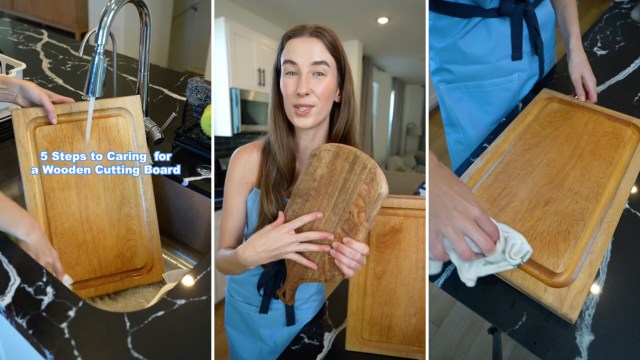Expert chef debunks common misconception about cutting boards: 'It is a myth'

It's a common misconception that wooden cutting boards retain bacteria longer than comparable cutting boards made from different materials. TikToker Kelly Scott (@kellyscleankitchen), a chef and culinary expert in Orange County, California, dispels the notion that you can't thoroughly clean a wooden cutting board.
The scoop
"Okay, so it is a myth that wooden cutting boards hold more bacteria than plastic," she says, kicking off the video.
@kellyscleankitchen How to care and clean for wooden cutting boards #cooking #cuttingboard #woodencuttingboard ♬ Wes Anderson-esque Cute Acoustic - Kenji Ueda
She's 100% correct, and she's corroborated by a study published in the National Library of Medicine by Dean Cliver and Nese Ak from the University of Wisconsin.
Wooden cutting boards outperformed their plastic counterparts in every way. There's an interesting irony at play here. It was long thought that the porous nature of a wooden cutting board is what makes it prone to a build-up of unsanitary bacteria.
But in fact, it's the porous surface that traps and kills bacteria. Kelly doesn't spend much time reminiscing about studies, however. She just shows her audience the best way to properly clean a wooden cutting board, the best variations to purchase, and how to give it longevity.
How it's helping
Kelly demonstrates, in five simple steps, how to properly care for cutting boards, leading off with the fact that wooden cutting boards are far more hygienic than plastic cutting boards. Of course, like any good kitchen tool, you have to clean it properly.
Watch now: How bad is a gas stove for your home's indoor air quality?
Kelly's video dispels the old myth while providing five solid steps for cleaning and maintaining a cutting board for long-term use. Thick, sturdy cutting boards without cracks and crevices are a customer's best bet.
For the burgeoning chefs out there, the cleaning process is rather straightforward, and Kelly leads by example throughout. Perhaps the most surprising part of the process is the addition of baking soda and oil.
Baking soda is a mild abrasive and a natural deodorizer, getting down into the pores of the wood for a better clean. Oiling the cutting board afterward gives it longevity by preventing drying and splitting, both of which are common as cutting boards age without oil.
What supplies do you keep on hand in case of a blackout?
Just a flashlight
A few camping lanterns
A full-on emergency kit
I don't have anything
Click your choice to see results and speak your mind.
Even better, the two work hand-in-hand, with the baking soda scouring and opening up the pores, and the oil filling in, returning moisture and restoration.
What everyone's saying
Kelly's TikTok followers jumped in to add a few additional options and preferences of their own.
"The best board you can get is an end grain cutting board. Shows fewer scratches from a knife and also is the best for your knives versus a straight grain board," one user commented.
Another user added: "Just get food-grade mineral oil to condition. At Walmart, it's just a couple of dollars and is found near the pharmacy."
Join our free newsletter for easy tips to save more and waste less, and don't miss this cool list of easy ways to help yourself while helping the planet.
Expert chef debunks common misconception about cutting boards: 'It is a myth' first appeared on The Cool Down.
Welcome to Billionaire Club Co LLC, your gateway to a brand-new social media experience! Sign up today and dive into over 10,000 fresh daily articles and videos curated just for your enjoyment. Enjoy the ad free experience, unlimited content interactions, and get that coveted blue check verification—all for just $1 a month!
Account Frozen
Your account is frozen. You can still view content but cannot interact with it.
Please go to your settings to update your account status.
Open Profile Settings